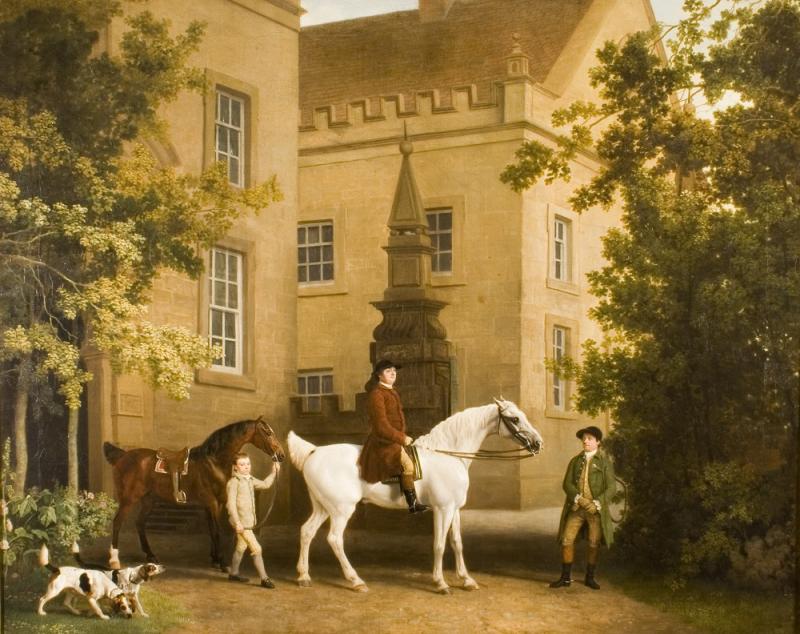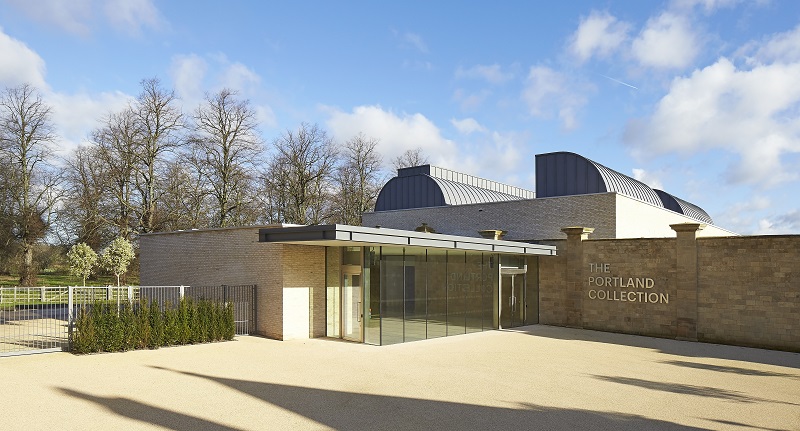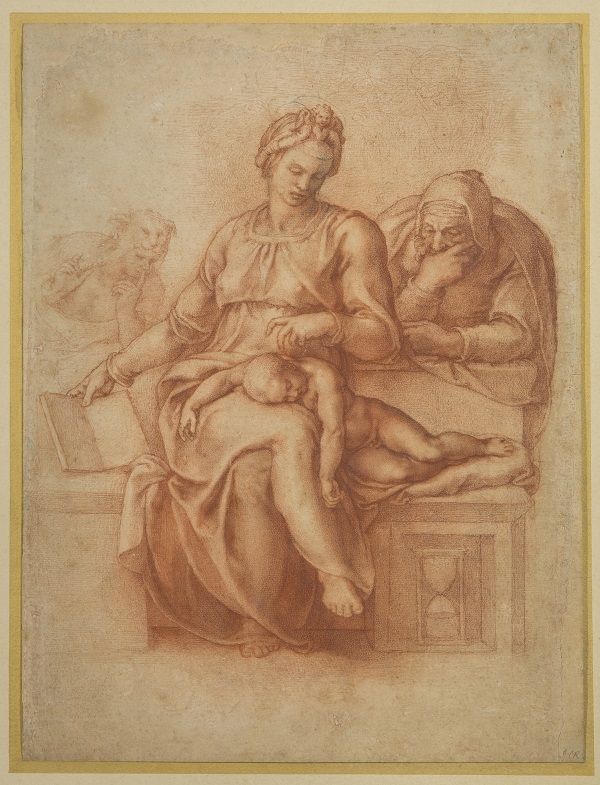Highlights from the Portland Collection, Harley Gallery, Welbeck | reviews, news & interviews
Highlights from the Portland Collection, Harley Gallery, Welbeck
Highlights from the Portland Collection, Harley Gallery, Welbeck
In the heart of Nottinghamshire, a new gallery showcases unimaginable treasures

Here be two modestly scaled masterpieces from the 1760s by George Stubbs, highlights of a centuries-old tradition of painting the horses owned by the Dukes of Newcastle and their lateral descendants the Dukes of Portland (the Devonshires are also connected in a grand web of aristocratic marriages). Stubbs was commissioned by the third Duke of Portland (1738-1809), William Cavendish-Bentinck, indisputably one of the grandest in the land: a politician and a multi-billionaire in today’s terms.
In one painting we see the third Duke with his extravagant younger brother Lord Edward Bentinck (reprimanded for not taking his aristocratic responsibilities seriously, although more than happy to spend the family income) watching a young horse being trained to jump. Stubbs also painted the Duke on horseback (main picture), accompanied by dogs, grooms and another horse being led out, in front of the huge riding school on the estate built by his ancestor, William Cavendish, the first Duke of Newcastle. These refined, exquisite paintings are in a long tradition of obsessive involvement with horse-breeding, training and racing, and Stubbs was the master of their portrayal, skilfully including dogs and human attendants, landscapes and buildings.
 Human members of the dynasty also feature, as well as a huge web of political and social entanglements. There are miniatures not only of family members but of royalty from all over Europe; silver for the grandest table settings, ornamental but working clocks, tapestries, the accoutrements of one of the richest households of the land. We complain about income inequalities in the 21st century, but in the 18th century a servant might earn five pounds a year, while the third Duke’s income was perhaps 3,500 times more than that figure. Even so, when he died the Duke left debts of half a million pounds.
Human members of the dynasty also feature, as well as a huge web of political and social entanglements. There are miniatures not only of family members but of royalty from all over Europe; silver for the grandest table settings, ornamental but working clocks, tapestries, the accoutrements of one of the richest households of the land. We complain about income inequalities in the 21st century, but in the 18th century a servant might earn five pounds a year, while the third Duke’s income was perhaps 3,500 times more than that figure. Even so, when he died the Duke left debts of half a million pounds.
The Harley Gallery is the newest attraction at the burgeoning Welbeck Estate in Nottinghamshire (nearest station, Rutland, nearest city, Sheffield). Designed by Hugh Broughton Architects, responsible inter alia for award-winning Antarctic research stations, it is exemplary, comfortable and adaptable, but also conveying with subtle ease that the building and its contents are special and worthy of attention.
Appealingly proportioned, with high ceilings and excellent lighting, the new gallery (pictured above right) consists of several discrete exhibition spaces, one flowing into another, and filled with treasures ranging from a Sévres tea service from the 1780s, to the Cartier diamond tiara of 1902 worn by the then Duchess at the Coronation of Edward VII. This is all by way of huge 1630s portraits of enormous horses set in indeterminate dramatic rocky landscapes, and family portraits by Van Dyck, and the 1838 trophy which marked Lord George Bentinck’s victory at Ascot.
 The main top-lit painting gallery is currently dedicated to large family and political portraits dating from the 17th and 18th centuries, not to mention a horse or two. The lighting throughout is excellent. The neighbouring galleries have a great variety of familial objects. On show is everything from extraordinary miniatures as fine as those at the Victoria & Albert Museum, to drawings, objets d’art, table silver and china, magnificent furniture, illuminated manuscripts, and sculpture – a miscellany of luxury. There are family portraits by John Singer Sargent and the society painter, the Hungarian Philip de László, and a photograph by Cecil Beaton of the sixth Duke of Portland’s half sister, the remarkable patron, lover and aficionado of Bloomsbury, Lady Ottoline Morrell. It was the sixth Duke who acquired one of the greatest treasures here, a 1540s drawing of the Holy Family by Michelangelo (pictured above left).
The main top-lit painting gallery is currently dedicated to large family and political portraits dating from the 17th and 18th centuries, not to mention a horse or two. The lighting throughout is excellent. The neighbouring galleries have a great variety of familial objects. On show is everything from extraordinary miniatures as fine as those at the Victoria & Albert Museum, to drawings, objets d’art, table silver and china, magnificent furniture, illuminated manuscripts, and sculpture – a miscellany of luxury. There are family portraits by John Singer Sargent and the society painter, the Hungarian Philip de László, and a photograph by Cecil Beaton of the sixth Duke of Portland’s half sister, the remarkable patron, lover and aficionado of Bloomsbury, Lady Ottoline Morrell. It was the sixth Duke who acquired one of the greatest treasures here, a 1540s drawing of the Holy Family by Michelangelo (pictured above left).
The exquisite early 17th century pearl earring worn by Charles I, a favourite jewel of the doomed king, who wore it at his execution, is on display, while a selection from the 400 miniatures in the family collection, here chosen by the artist Peter Blake, includes one of Henry VIII in later life. This shows him plump-faced and almost sneering, certainly not someone whose displeasure you would wish to evoke. Gheeraerts's 1580s painting of his daughter, the Virgin Queen, shows her bejewelled, crowned and wholly inscrutable, her face an impassive mask.
Of course the opening of the Harley Gallery brings financial advantages for the Welbeck Estate, as inheritance tax is waived for works of art that are publicly accessible. By moving highlights of the family holdings into a public gallery (with no admission charge) that access requirement is fulfilled; Welbeck Abbey itself is only open to the public for guided tours in August. A combination of private philanthropy, good accountancy for the family, and government subsidy means that masterpieces of the fine and decorative arts – furniture, miniatures, books, portraits, jewellery – entwined with four centuries of history, are on view.
The Harley Gallery amply fulfils the requirements of the successful public showing of works of art. Its contents – the selection will be changed every three years – are idiosyncratic, interesting, unusual, and cast light on family history, art history, and, well, just history in general. The environment is comfortable and visitors are at ease: the new Harley Gallery is special, accessible – and free.
rating
Share this article
The future of Arts Journalism
You can stop theartsdesk.com closing!
We urgently need financing to survive. Our fundraising drive has thus far raised £49,000 but we need to reach £100,000 or we will be forced to close. Please contribute here: https://gofund.me/c3f6033d
And if you can forward this information to anyone who might assist, we’d be grateful.

Subscribe to theartsdesk.com
Thank you for continuing to read our work on theartsdesk.com. For unlimited access to every article in its entirety, including our archive of more than 15,000 pieces, we're asking for £5 per month or £40 per year. We feel it's a very good deal, and hope you do too.
To take a subscription now simply click here.
And if you're looking for that extra gift for a friend or family member, why not treat them to a theartsdesk.com gift subscription?
more Visual arts
 'We are bowled over!' Thank you for your messages of love and support
Much-appreciated words of commendation from readers and the cultural community
'We are bowled over!' Thank you for your messages of love and support
Much-appreciated words of commendation from readers and the cultural community
![SEX MONEY RACE RELIGION [2016] by Gilbert and George. Installation shot of Gilbert & George 21ST CENTURY PICTURES Hayward Gallery](https://theartsdesk.com/sites/default/files/styles/thumbnail/public/mastimages/Gilbert%20%26%20George_%2021ST%20CENTURY%20PICTURES.%20SEX%20MONEY%20RACE%20RELIGION%20%5B2016%5D.%20Photo_%20Mark%20Blower.%20Courtesy%20of%20the%20Gilbert%20%26%20George%20and%20the%20Hayward%20Gallery._0.jpg?itok=7tVsLyR-) Gilbert & George, 21st Century Pictures, Hayward Gallery review - brash, bright and not so beautiful
The couple's coloured photomontages shout louder than ever, causing sensory overload
Gilbert & George, 21st Century Pictures, Hayward Gallery review - brash, bright and not so beautiful
The couple's coloured photomontages shout louder than ever, causing sensory overload
 Lee Miller, Tate Britain review - an extraordinary career that remains an enigma
Fashion photographer, artist or war reporter; will the real Lee Miller please step forward?
Lee Miller, Tate Britain review - an extraordinary career that remains an enigma
Fashion photographer, artist or war reporter; will the real Lee Miller please step forward?
 Kerry James Marshall: The Histories, Royal Academy review - a triumphant celebration of blackness
Room after room of glorious paintings
Kerry James Marshall: The Histories, Royal Academy review - a triumphant celebration of blackness
Room after room of glorious paintings
 Folkestone Triennial 2025 - landscape, seascape, art lovers' escape
Locally rooted festival brings home many but not all global concerns
Folkestone Triennial 2025 - landscape, seascape, art lovers' escape
Locally rooted festival brings home many but not all global concerns
 Sir Brian Clarke (1953-2025) - a personal tribute
Remembering an artist with a gift for the transcendent
Sir Brian Clarke (1953-2025) - a personal tribute
Remembering an artist with a gift for the transcendent
 Emily Kam Kngwarray, Tate Modern review - glimpses of another world
Pictures that are an affirmation of belonging
Emily Kam Kngwarray, Tate Modern review - glimpses of another world
Pictures that are an affirmation of belonging
 Kiefer / Van Gogh, Royal Academy review - a pairing of opposites
Small scale intensity meets large scale melodrama
Kiefer / Van Gogh, Royal Academy review - a pairing of opposites
Small scale intensity meets large scale melodrama
 Jenny Saville: The Anatomy of Painting, National Portrait Gallery review - a protégé losing her way
A brilliant painter in search of a worthwhile subject
Jenny Saville: The Anatomy of Painting, National Portrait Gallery review - a protégé losing her way
A brilliant painter in search of a worthwhile subject
 Abstract Erotic, Courtauld Gallery review - sculpture that is sensuous, funny and subversive
Testing the boundaries of good taste, and winning
Abstract Erotic, Courtauld Gallery review - sculpture that is sensuous, funny and subversive
Testing the boundaries of good taste, and winning
 Edward Burra, Tate Britain review - watercolour made mainstream
Social satire with a nasty bite
Edward Burra, Tate Britain review - watercolour made mainstream
Social satire with a nasty bite
 Ithell Colquhoun, Tate Britain review - revelations of a weird and wonderful world
Emanations from the unconscious
Ithell Colquhoun, Tate Britain review - revelations of a weird and wonderful world
Emanations from the unconscious

Add comment